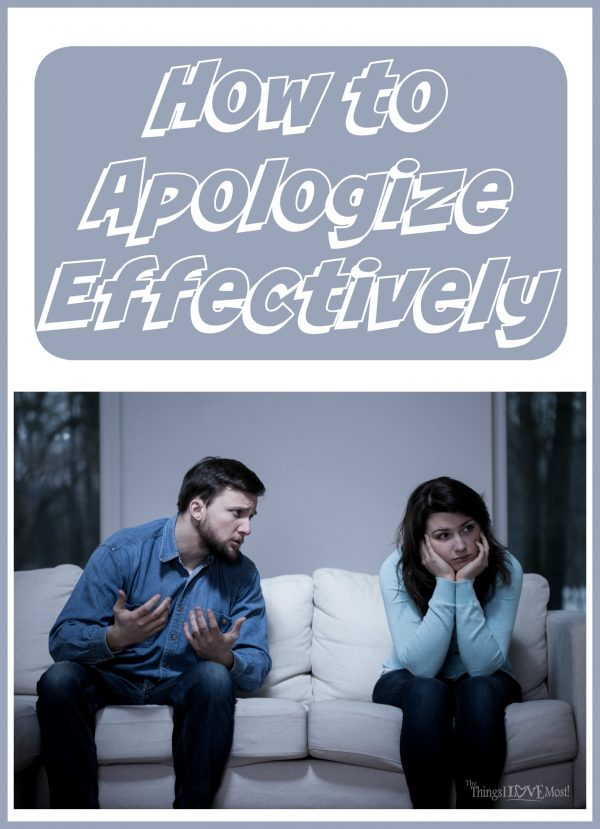I have been thinking a lot lately how important it is to teach my kid to apologize. How to teach them to truly mean they are sorry after they do something wrong. My little boys are 3 and 5 and every day I have to help them apologize to each other and to others they are unkind to. After reading this guest post by Christine Hill I realize how important it is for them to learn this at a young age so that they can apologize effectively in the future when they are adults!
How to Apologize Effectively
By Christine Hill
Someone once told me that the most important words to learn in a marriage are “I’m sorry.” I’m still not an expert at marriage, but I have learned that apologies are vital for any healthy relationship. Offense is inevitable, and it’s important to take a moment to show your partner that you value your connection more than you value a petty grudge. In order to re-establish trust, it’s important to apologize–not just frequently, but effectively.

Beware Faux Apology Styles
If apology is a clean bandage on a wound, a fake apology is a dirty one, which can make the original injury fester, all under a cover that makes you think that things are okay. Why do we do it? Even though we notice that something went wrong, we’re trying to preserve the ideal image of ourselves. We defend ourselves, downplay the problem, and even pin the blame on someone else. Here are some ways you might make that mistake:
● “I’m sorry you feel that way.”
● “This is so unlike me, I never do stuff like this.”
● “I’m sorry, I’m just so tired. I didn’t sleep last night at all.”
● “If only you had taught me how I’m actually supposed to do it…”
And most of all, beware the dismissive “I’m sorry!” that actually means “I’m over it and I don’t want to discuss it anymore, so I’m checking out.”

Apologize with Vulnerability
Why do we shy away from genuine apologies? Ultimately, we’re worried that we’re not actually enough. We’re scared that we can’t become more than this mistake. Brene Brown pointed out the toxicity of shame when we apologize: sometimes we avoid saying “sorry I made a mistake” because we’re afraid it means, “Sorry, I AM a mistake.” We’re petrified that our potential is a fixed quantity that cannot be added to, only taken from.
That’s why Karina Schumann, a psychologist and researcher at Stanford, says that practicing self-affirmation before apologizing can make our apologies more effective and better-received. She had subjects write a list of their personal values and qualities. Afterwards, their apologies were more sincere and less defensive.
Understand Different Apology Styles
Another way to make sure that your apologies are effective is communicating in the style that your partner is most receptive to. How often have you FELT like you sincerely apologized but then realized that the other person was still waiting for something more from you? This often happens because of a disconnect in apology languages.
The 5 Languages of Apology by Gary Chapman and Jennifer Thomas confronts the divide between different apology languages. Much like they did in their widely read book The 5 Love Languages, they once again examine the source of miscommunication in relationships. While we think that we’ve confronted something or given or shown something, our message might fail to land because of a language barrier. It’s not what the other person prefers to receive. We might be apologizing, but it’s not answering their needs. This just creates a “you-owe-me” cycle that’s hard to break out of.

Here’s a summary of the 5 “apology languages”:
1: Expressing Regret: This apology style is probably the most straightforward, wherein all the person is really looking for is a sincere “I’m sorry” that obviously comes from the heart. Usually, the sincerity needs to be conveyed through tone, body language, and eye contact in order to be fully communicated.
2: Accept Responsibility: This style is usually especially important to those who greatly care about justice. It’s the style that needs to hear the words, “I was wrong” in order to make things right again. This importance lies in the idea that the other person needs to humble themselves and acknowledge the way things should actually be before the two of you can move forward.
3: Genuinely Repent: The person who is looking for this apology style will only accept an apology if it’s accompanied by a plan of action and a resolve to never make the same mistake again. It’s important for the offender to verbalize their resolve to change and be better.
4: Make Restitution: Just as the name says, this apology style requires amends to be made. Someone who needs to hear this apology style will expect that if an apology is truly sincere, the other person will take action to make it right again. That might mean reimbursing someone for time or money lost. However, in a close relationship, most of the time that means showing the other person that you value the relationship, using whatever approach makes them feel loved and appreciated.
5: Ask Forgiveness: Requesting forgiveness lets the other person know that you acknowledge that the fate of the relationship is in their hands, whether they choose to forgive you or not. It means that you acknowledge that you’ve damaged the relationship and that you desire to repair it until it’s fully restored, but you realize that you can’t demand forgiveness from your partner, and can only humbly ask.
Knowing your spouse’s apology style can protect you from a lot of hurt and miscommunication when challenges come. In the case of apologies to people that you don’t know as well, you’ll often need to strive for apologies that will cover all of your bases. The crux of this idea is that you need to realize that apologizing isn’t about doing what YOU feel is fair, it’s about effectively communicating with the other party and providing what THEY need in order to re-orient the relationship and re-establish trust.





